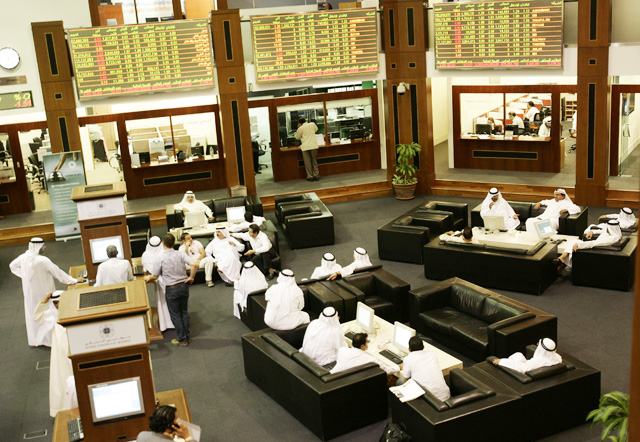Given the degree of volatility in global financial markets last week as a result of the US presidential election the UAE markets held up pretty well. Volatility increased in the local markets but no significant change to the overall pattern occurred, and by the end of the week UAE markets were close to where they started.
Dubai
The Dubai Financial Market General Index (DFMGI) fell 24.37 or 0.74 per cent last week to end at 3,274.06. Market breadth was essentially even with 18 advancing issues and 19 declining, while volume spiked to a 28-week high. This is the fifth week in a row that the index has moved less than 0.75 per cent up or down from the prior week’s close.
Last Wednesday, given the US presidential election, the DFMGI fell to 3,273.96 as it tested a prior support zone that goes down to a low of 3,197.32. By the end of the day the index recovered more than half of the decline to end in the top part of the day’s range. A bearish trend continuation signal was given as the index fell below the prior bottom (3,253.21) of an eleven-week downtrend. However, there has not been a daily close below that price level indicating that the support range reached last week has a chance to hold thereby providing the DFMGI an opening to find a bottom and rally.
At the same time, given last week’s fall, the eleven-week downtrend remains well intact. Further, when stepping back to get a wider view of the chart pattern developing over the past six months or so a large potential double top trend reversal pattern becomes apparent. This becomes significant if there is a decisive daily close below the 3,197.32 low. Until then the DFMGI should continue to trade in a range as it has for the past six months or so.
On the upside the first sign of strength will be on a daily close above last week’s high of 3,318.85, and then on a rally above the prior week’s high at 3,344.11. But, the index needs to see a daily close above the three-week high of 3,368.30 before we can renew confidence that it may continue higher. That high occurred at the most recent swing high that defines the pattern of the downtrend on a daily basis.
Abu Dhabi
Last week the Abu Dhabi Securities Exchange General Index (ADI) barely budged, up only 0.84 or 0.02 per cent to close at 4,282.46. There were 15 advancing issues and 16 declining, while volume for the week jumped to the highest level since April 2015.
The spike in volume that occurred without a significant move in price can be considered a bullish sign. Not enough by itself to take action, but when combined with other analysis strengthens the bullish case for the near-term. Many times spikes in volume that occur without much change in price are precursors to sharp definitive moves.
For the past four-week’s the ADI has been consolidating just above the 4,216.93 low. The high of the range is now at last week’s high of 4,349.91. This consolidation range can best be seen on the weekly chart. The four-week low, at least temporarily, halted an 11-week decline off the 4,621.5 July peak and the subsequent consolidation is a time for investors to fight it out to determine whether the downtrend will continue lower or a bottom will be completed leading to a move higher.
A bullish breakout above the high of the range in general should lead to more aggressive buying in the short-term, while the strong volume last week supports this scenario. However, when taking a closer look at the range via the daily chart the four-week pattern takes the form of a small ascending trend channel. Unless there is a sharp and decisive move above last week’s high the ADI could continue to progress in this channel, which would therefore lead to higher prices but with a less aggressive progression.
Key upside target areas to watch include 4,373 and 4,419, which are the 38.2 per cent per cent Fibonacci retracement levels, respectively. Above there is a potential resistance range from approximately 4,443 to 4,524, which includes the 61.8 per cent Fibonacci retracement at 4,467.
Stocks to watch
DXB Entertainments finished the week unchanged at 1.54. This follows a drop to 1.46 earlier in the week and a test of 1.45 support hit six weeks ago. This support zone of 1.46/1.45 is right around previous resistance from back in March and April. It is where support would be expected to be seen for the long-term uptrend’s evolution and is bullish price behaviour if further strength is seen hereafter.
Since hitting a 2016 high of 1.77 in August DXB has pulled back 18 per cent. Last week’s low creates a potential second bottom of a developing double bottom trend reversal pattern at noted support. However, this pattern doesn’t trigger for a while, not until we see a move above the three-week high of 1.66. Instead a decisive move above last week’s high at 1.56 can be used as an aggressive signal substitute, given the other bullish factors discussed above. A drop below last week’s low would be short-term bearish.
Bruce Powers, CMT, is chief technical analyst at www.MarketsToday.net. He is based in Dubai.













